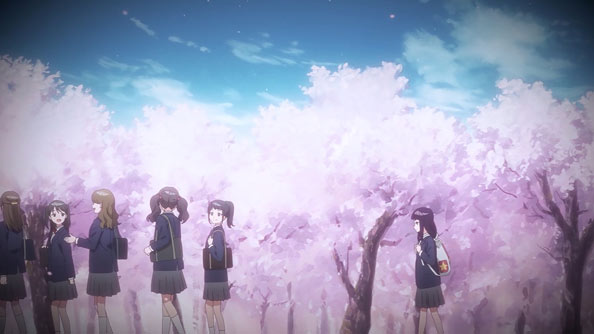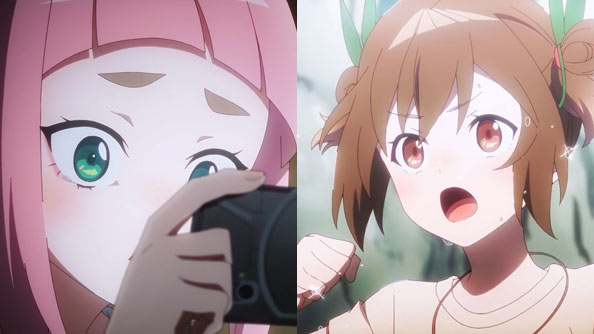
Simply diving into a review immediately after watching a film as devastatingly gorgeous and emotionally affecting as Kimi no Na wa is probably not a great idea, but this is an anime review blog, so here goes.
Kimi no Na wa isn’t just a charming body-swap rom-com, or a time-travelling odyssey, or a disaster prevention caper, or a tale of impossibly cruel temporal and physical distance between two soul mates, or a reflection on the fragility and impermanence of everything from memories to cities, or a tissue-depleting tearjerker.
It’s all of those things and more. And it’s also one of, if not the best, movies I’ve ever seen, anime or otherwise.

After a cryptic prologue, Kimi no Na wa starts out modestly: Miyamizu Mitsuha, Shinto shrine maiden and daughter of a mayor, has grown restless in her small town world, so one night, shouts out tot he night that she wants to be reborn as a boy in Tokyo.
This, mind you, happens after an odd incident in which Mitsuha essentially lost a day, during which all her family and friends say she was acting very strange and non-Mitsuha-y…like a different person.
That’s because she was. She and a boy from Tokyo, Tachibana Taki, randomly swap bodies every so often when they’re dreaming. As such, they end up in the middle of their couldn’t-be-any-different lives; the only similarity being that both of them yearn for more.

Despite just meeting these characters, watching Mitsuha and Taki stumble through each other’s lives is immensely fun. And because this is a Shinkai film, that enjoyment is augmented by the master director’s preternatural visual sumptuousness and realism. Every frame of Mitsuha’s town and the grand vastness of Tokyo is so full of detail I found myself wanting to linger in all of them.

As the body-swapping continues, the two decide to lay down “ground rules” when in one another’s bodies—albeit rules both either bend or break with impunity—and make intricate reports in one another’s phone diaries detailing their activities during the swaps.
Interestingly, Mitsuha makes more progress with Taki’s restaurant co-worker crush Okudera than Taki (she like’s Taki’s “feminine side”), while the more assertive Taki proves more popular with boys and girls when Taki’s in her body.

Taki happens to be in Mitsuha’s body when her grandmother and sister Yotsuha make the long, epic trek from their home to the resting place of the “body” of their Shinto shrine’s god, an otherworldly place in more ways than one, to make an offering of kuchikamisake (sake made from saliva-fermented rice).
While the three admire the sunset, Mitsuha’s granny takes a good look at her and asks if he, Taki, is dreaming. Just then he wakes up back in his own body to learn Mitsuha has arranged a date with him and Okudera—one she genuinely wanted to attend.
Okudera seems to notice the change in Taki from the one Mitsuha inhabited; she can tell his mind is elsewhere, and even presumes he’s come to like someone else. Taki tries to call that someone else on his phone, but he gets an automated message.

Then, just like that, the body-swapping stops.
After having cut her hair, her red ribbon gone, Mitsuha attends the Autumn Festival with her friends Sayaka and Teshi. They’re treated to a glorious display in the night sky, as the comet Tiamat makes its once-every-1,200-years visit.
Taki decides if he can’t visit Mitsuha’s world in his dreams anymore, he’ll simply have to visit Mitsuha. Only problem is, he doesn’t know exactly what village she lives in. Okudera and one of his high school friends, who are worried about him, decide to tag along on his wild goose chase.
After a day of fruitless searching, Taki’s about to throw in the towel, when one of the proprietors of a restaurant notices his detailed sketch of Mitsuha’s town, recognizing it instantly as Itomori. Itomori…a town made famous when it was utterly destroyed three years ago by a meteor created from a fragment of the comet that fell to earth.

The grim reality that Taki and Mitsuha’s worlds were not in the same timeline is a horrendous gut punch, as is the bleak scenery of the site of the former town. Every lovingly-depicted detail of the town, and all of its unique culture, were blasted into oblivion.
Taki is incredulous (and freaked out), checking his phone for Mitsuha’s reports, but they disappear one by one, like the details of a dream slipping away from one’s memory. Later, Taki checks the register of 500 people who lost their lives in the disaster, and the punches only grow deeper: among the lost are Teshi, Sayaka…and Miyamizu Mitsuha.

After the initial levity of the body-swapping, this realization was a bitter pill to swallow, but would ultimately elevate the film to something far more epic and profound, especially when Taki doesn’t give up trying to somehow go back to the past, get back into Mitsuha’s body, and prevent all those people from getting killed, including her.
The thing that reminds him is the braided cord ribbon around his wrist, given to him at some point in the past by someone he doesn’t remember. He returns to the site where the offering was made to the shrine’s god, drinks the sake made by Mitsuha, stumbles and falls on his back, and sees a depiction of a meteor shower drawn on the cave ceiling.
I haven’t provided stills of the sequence that follows, but suffice it to say it looked and felt different from anything we’d seen and heard prior in the film, and evoked emotion on the same level as the famous flashback in Pixar’s Up. If you can stay dry-eyed during this sequence, good for you; consider a career being a Vulcan.

Taki then wakes up, miraculously back in Mitsuha’s body, and sets to work. The same hustle we saw in Taki’s restaurant job is put to a far more important end: preventing a horrific disaster. The town itself may be doomed—there’s no stopping that comet—but the people don’t have to be.
Convincing anyone that “we’re all going to die unless” is a tall order, but Taki doesn’t waver, formulating a plan with Teshi and Sayaka, and even trying (in vain) to convince Mitsuha’s father, the mayor, to evacuate.
While the stakes couldn’t be higher and the potential devastation still clear in the mind, it’s good to see some fun return. Sayaka’s “we have to save the town” to the shopkeep is a keeper.

Meanwhile, Mitsuha wakes up in the cave in Taki’s body, and is horrified by the results of the meteor strike. She recalls her quick day trip to Tokyo, when she encountered Taki on a subway train, but he didn’t remember her, because it would be three more years before their first swap.
Even so, he can’t help but ask her her name, and she gives it to him, as well as something to remember her by later: her hair ribbon, which he would keep around his wrist from that point on.

Both Taki-as-Mitsuha and Mitsuha-as-Taki finally meet face-to-face, in their proper bodies, thanks to the mysterious power of kataware-doki or twilight. It’s a gloriously-staged, momentous, and hugely gratifying moment…
…But it’s all too brief. Taki is able to write on Mitsuha’s hand, but she only gets one stoke on his when twilight ends, and Taki finds himself back in his body, in his time, still staring down that awful crater where Itomori used to be. And again, like a dream, the more moments pass, the harder it gets for him to remember her.

Back on the night of the Autumn Festival, Mitsuha, back in her time and body, takes over Taki’s evacuation plan. Teshi blows up a power substation with contractor explosives and hacks the town-wide broadcast system, and Sayaka sounds the evacuation. The townsfolk are mostly confused, however, and before long Sayaka is apprehended by authorities, who tell everyone to stay where they are, and Teshi is nabbed by his dad.
With her team out of commission, it’s all up to Mitsuha, who races to her father to make a final plea. On the way, she gets tripped up and takes a nasty spill. In the same timeline, a three-years-younger Taki, her ribbon around his wrist, watches the impossibly gorgeous display in the Tokyo sky as the comet breaks up. Mitsuha looks at her hand and finds that Taki didn’t write his name: he wrote “I love you.”

The meteor falls and unleashes a vast swath of destruction across the landscape, not sparing the horrors of seeing Itomori wiped off the face of the earth—another gut punch. Game Over, too, it would seem. After spending a cold lonely night up atop the former site of the town, he returns to Tokyo and moves on with his life, gradually forgetting all about Mitsuha, but still feeling for all the world like he should be remembering something, that he should be looking for someplace or someone.
Bit by bit, those unknowns start to appear before him; a grown Sayaka and Teshi in a Starbucks; a passing woman with a red ribbon in her hair that makes him pause, just as his walking by makes her pause. But alas, it’s another missed connection; another classic Shinkai move: they may be on the same bridge in Shinjuku, but the distance between them in time and memory remains formidable.

Mitsuha goes job-hunting, enduring one failed interview after another, getting negative feedback about his suit from everyone, including Okudera, now married and hopeful Taki will one day find happiness.
While giving his spiel about why he wants to be an architect, he waxes poetic about building landscapes that leave heartwarming memories, since you’ll never know when such a landscape will suddenly not be there.
A sequence of Winter scenes of Tokyo flash by, and in light of what happened to Itomori quite by chance, that sequence makes a powerful and solemn statement: this is Tokyo, it is massive and complex and full of structures and people and culture found nowhere else in the world, but it is not permanent.
Nothing built by men can stand against the forces of nature and the heavens. All we can do is live among, appreciate, and preseve our works while we can. We’re only human, after all.

And yet, for all that harsh celestial certainty, there is one other thing that isn’t permanent in this film: Taki and Mitsuha’s separation. Eventually, the two find each other through the windows of separate trains, and race to a spot where they experience that odd feeling of knowing each other, while also being reasonably certain they’re strangers.
Taki almost walks away, but turns back and asks if they’ve met before. Mitsuha feels the exact same way, and as tears fill their eyes, they ask for each others names. Hey, what do you know, a happy ending that feels earned! And a meteor doesn’t fall on Tokyo, which is a huge bonus.
Last August this film was released, and gradually I started to hear rumblings of its quality, and of how it could very well be Shinkai’s Magnum Opus. I went in expecting a lot, and was not disappointed; if anything, I was bowled over by just how good this was.
Many millions of words have been written about Kimi no Na wa long before I finally gave it a watch, but I nevertheless submit this modest, ill-organized collection words and thoughts as a humble tribute to the greatness I’ve just witnessed. I’ll be seeing it again soon.
And if for some reason you haven’t seen it yourself…what are you doing reading this drivel? Find it and watch it at your nearest convenience. You’ll laugh; you’ll cry; you’ll pump your fist in elation.


























